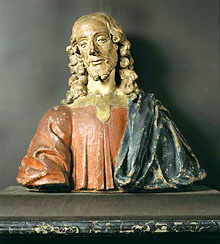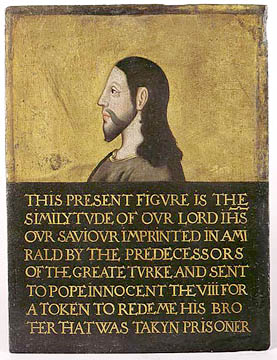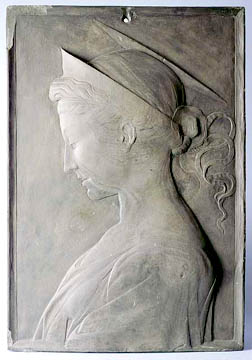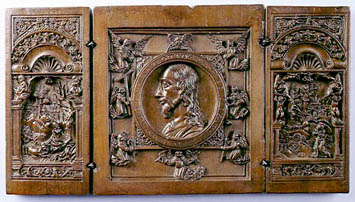 Bust
of Christ Bust
of ChristAndrea del Verrocchio (1435-1488) Florentine, after 1483 Gessoed, painted, and gilded terra cotta This life sized bust is modeled after the statue of Christ in Verrochio’s Christ and Saint Thomas, dating to 1483 located on the façade of Orsanmichele in Florence. The iconographic type represented here takes its cues from the Lentulus Letter allegedly written by a Lentulus, a Roman official in the century. The letter is famous for the description of Jesus’ appearance it contains. The letter as it appears in a thirteenth-century text reads: In these days there appeared, and there still is, a man of great power named Jesus Christ, who is called by the Gentiles the prophet of truth, whom his disciples call the Son of God, raising the dead and healing diseases- a man in stature middling tall, and comely, having a reverend countenance, which those who look upon may love and fear; having hair the hue of an unripe hazel-nut and smooth almost down to his ears, but from the ears in curling locks somewhat darker and more shining, flowing over his shoulders; having a parting at the middle of the head according to the fashion of the Nazarenes; a brow smooth and very calm, with a face without wrinkle or any blemish, which a moderate red color makes beautiful; with the nose and mouth no fault at all can be found; having a full beard the color of his hair, not long, but a little forked at the chin; having an expression simple and mature, the eyes gray, flashing, and clear; in rebuke terrible, in admonition kind and lovable, cheerful yet keeping gravity; sometimes he has wept, but never laughed; in stature of body tall and straight, with hands and arms fair to look upon; in talk grave, reserved and modest, fairer than the children of men. |
|
“True Likeness” of Christ with Saints Jerome and
Francis The profile of Jesus carved in the roundel at the center of this triptych is believed to have been carved after a bronze medal by Niccolo Fiorentino. Seven angels, five of whom hold the arma christi, the instruments of the passion, support the roundel at its frame. Saints Jerome and Francis are carved on the flanking triptych wings. On the left St. Jerome is depicted in a typical scene: kneeling before a crucifix, a tame lion by his side. On the right, St. Francis is illustrated receiving the stigmata. The two saints may have been included in the composition because they were the name saints of the patron. |
 Portrait
of Christ Portrait
of ChristEnglish, reign of Henry VII (r. 1485-1509) Prepared oak panel This depiction of Jesus in profile is derived from an image found on the emerald vernicle. Like Veronica’s veil and the mandylion of Edessa, the emerald vernicle, though not miraculous, was accepted as a portrait of Jesus. Around 1429 Sultan Bazajet II of Constantinople gave the emerald, carved with the profile of Jesus, to Pope Innocent VIII. Bajazet II proffered the emerald insure that his brother would remain in papal custody thus securing his own ascension to the throne. The inscription underneath the portrait relays this story although the painter has changed the intention behind the gift. The inscription reads: “This present figure if the similitude of our Lord Jesus our savior imprinted in emerald by the predecessors of the great Turk and sent to Pope Innocent the VIII for a token to redeem his brother that was taken prisoner.” |
 Profile
of the Young Virgin Mary Profile
of the Young Virgin MaryDesiderio da Settignano (1429/32-1464) Florentine, mid-15th century Pietra Serena schiacciato relief |
